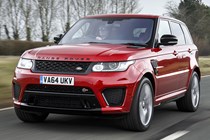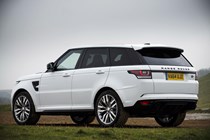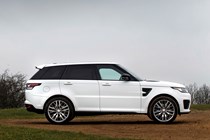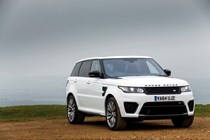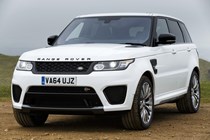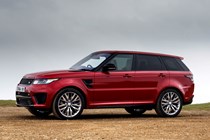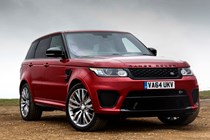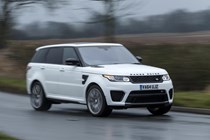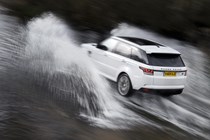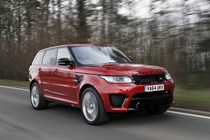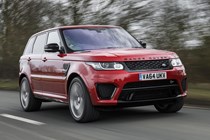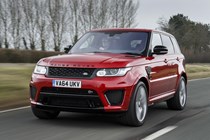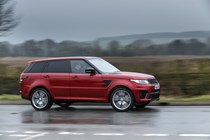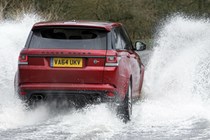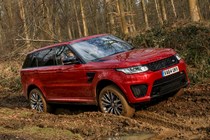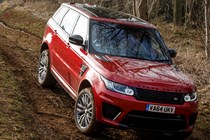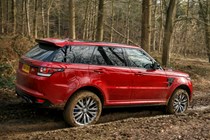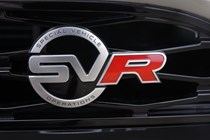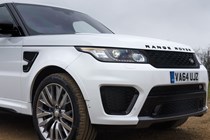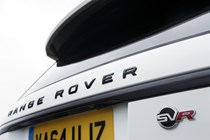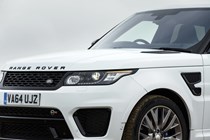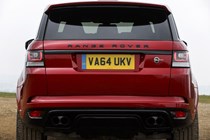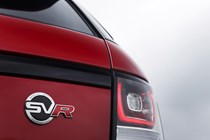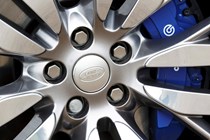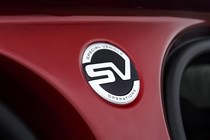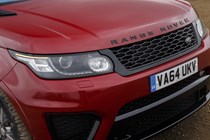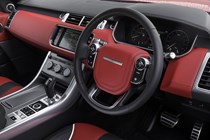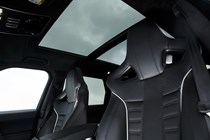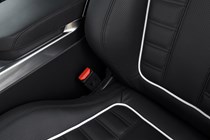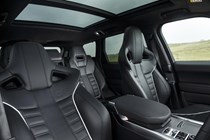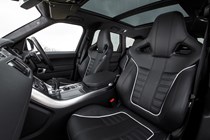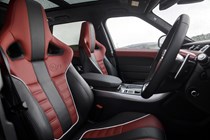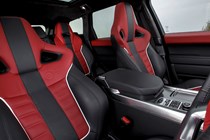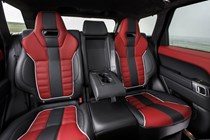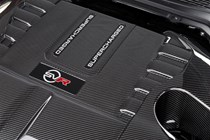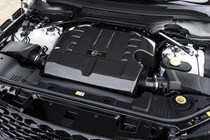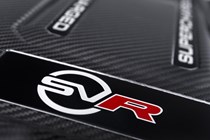
Range Rover Sport SVR (2015-2017) engines, drive and performance
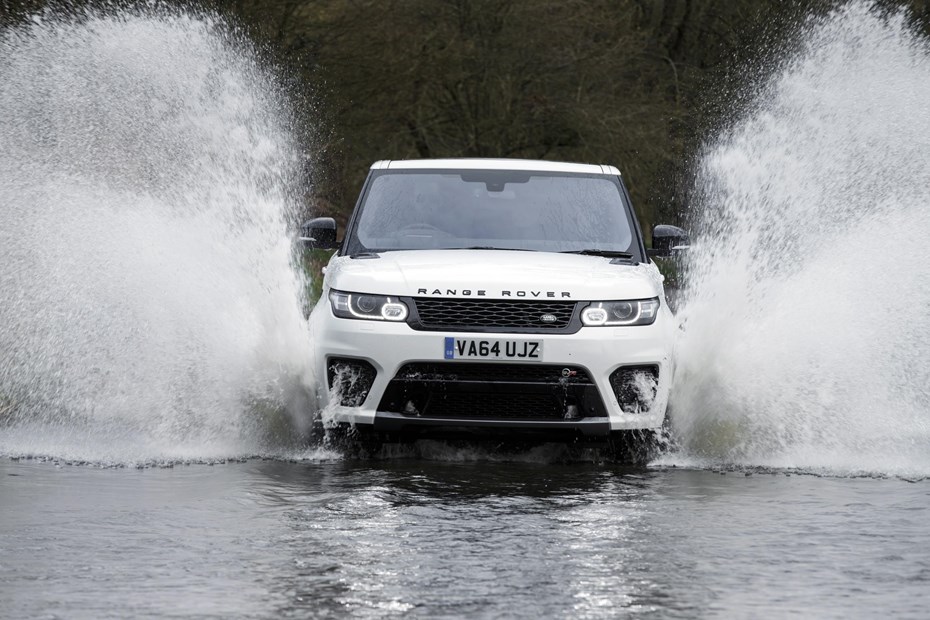
There’s only one engine for this car, but thanks to its 5-litre supercharged V8 petrol engine and its 542bhp output, Land Rover Range Rover Sport SVR performance is nothing short of staggering.
Depress the throttle fully and you’re treated to a searing bark from the active exhaust, a two stage system with electronically controlled valves. With a 5mm larger diameter than the standard Land Rover Range Rover Sport Supercharged’s exhaust this system opens its valves around 3,000rpm for maximum noise, though this is augmented by a symposer which filters induction noise into the cabin. Those who’re keen to fly under the radar can choose to run in a quiet(er) mode at any time, though the hilarious crackling, popping and banging from the exhaust tips on the overrun induce such a grin it’s worth leaving alone.
Alongside the crackling exhaust pipes is a cracking set of stats, the near 2.3-tonne Land Rover Range Rover Sport SVR accelerating from 0-62mph in just 4.7 seconds. Thanks to its four-wheel drive, which can send all of its torque to the front or rear axle depending on the conditions and requirements, grip is incredible and the SVR rockets off the line – especially with the specially developed 22-inch Continental SportContact 5 tyres. Given a long enough runway, or deserted stretch of Autobahn the SVR will crack 162mph before its limiter cuts in.
And it feels just as fast as those figures suggest, the nose raising slightly, reminiscent of a powerful speedboat planing up through open water, towards the horizon and the SVR punches towards it. It never feels anything but composed and controlled though, even if the addictive acceleration may feel slightly at odds with the Land Rover Range Rover Sport SVR’s SUV make-up.
It’s not just the engine, with 40bhp and 56Nm more than the standard Supercharged car’s unit, that has come under scrutiny though – the gearbox has received some tweaks too. For a start it’s set up to handle more torque in its lower gears and the eight individual ratios are closely stacked. A new fuel cut off system means upshifts are around 50 percent faster and the shifts certainly feel fast.
Despite their stacking they feel well-spread too, with a relaxed cruise eminently possible, and eight-speed gearbox monitors driver inputs and vehicle forces – along with gradient severity – before choosing one of 25 programmes to adapt. Around corners the ‘box uses Corner Recognition to ensure it remains in one gear all the way round a bend so as not to upset the car’s cornering attitude. Same goes for overtaking, when the car will maintain a lower gear for greater acceleration.
Drill down into it and the stats about the SVR are rather revealing – for a start it weighs over 2.3 tonnes. When you consider the best sports cars weigh around half that, you have to question whether extra power can really make up for that extra mass. But the firm spent around 14,000 miles at the legendary Nurburgring and 38,000 miles completing high-speed testing at the Nardo facility in Italy to ensure it could.
And on first impressions the answer looks to be yes; there’s no doubt this Land Rover Range Rover Sport SVR fulfils its brief of being the most focused Land Rover Range Rover Sport so far. Road or track it showcases serious grip levels and an uncanny resistance to roll, pitch and dive, and even the most cynical should be tickled by its ability to ford rivers one moment and clip apexes the next.
Underneath the tweaked body the suspension and chassis elements haven’t escaped attention from SVO’s engineers either, and the rear subframe bushes have been beefed up (by 20 percent), the suspension’s air springs uprated and the dampers optimised for agility rather than comfort or off-road scrambling.
Officially that’s helped result in a peak cornering g-force increased from the standard car’s 1.1g to the SVR’s 1.3g. The continuously variable dampers monitor the vehicle’s movements and the demands being made of it 500 times a second, plus driver’s can choose from settings on the move at the touch of a button.
Active Roll Control (ARC) replaces traditional anti-roll bars and uses hydraulic pump actuators, adapting to body accelerations up to 1,000 times a second, to work against the lateral movement of the axle at every corner and keep the Land Rover Range Rover Sport SVR flat through bends. Choose dynamic mode and its resistance to unwanted body movement is even greater.
The Electric Power Assisted Steering (EPAS) is a variable-ratio speed-sensitive system, but despite the added weight at higher speeds it always feels too light and lacking in feel and feedback. In fact this is one of the car’s most obvious failings, as you’ll struggle to really tell what the front wheels are doing, with little information coming back through the column to your digits wrapped round the wheel.
It’s a feeling not helped by the car adopting such a flat cornering attitude, the SVR lacking the forewarning through body movement that it’s about to relinquish grip around a corner. With the safety systems left to their own devices the flicker of the stability control light is noticeable – certainly the Porsche Cayenne may feel like it moves around more, but conversely it also squats down at the rear, grips, and accelerates away with more feedback and involvement for the driver.


